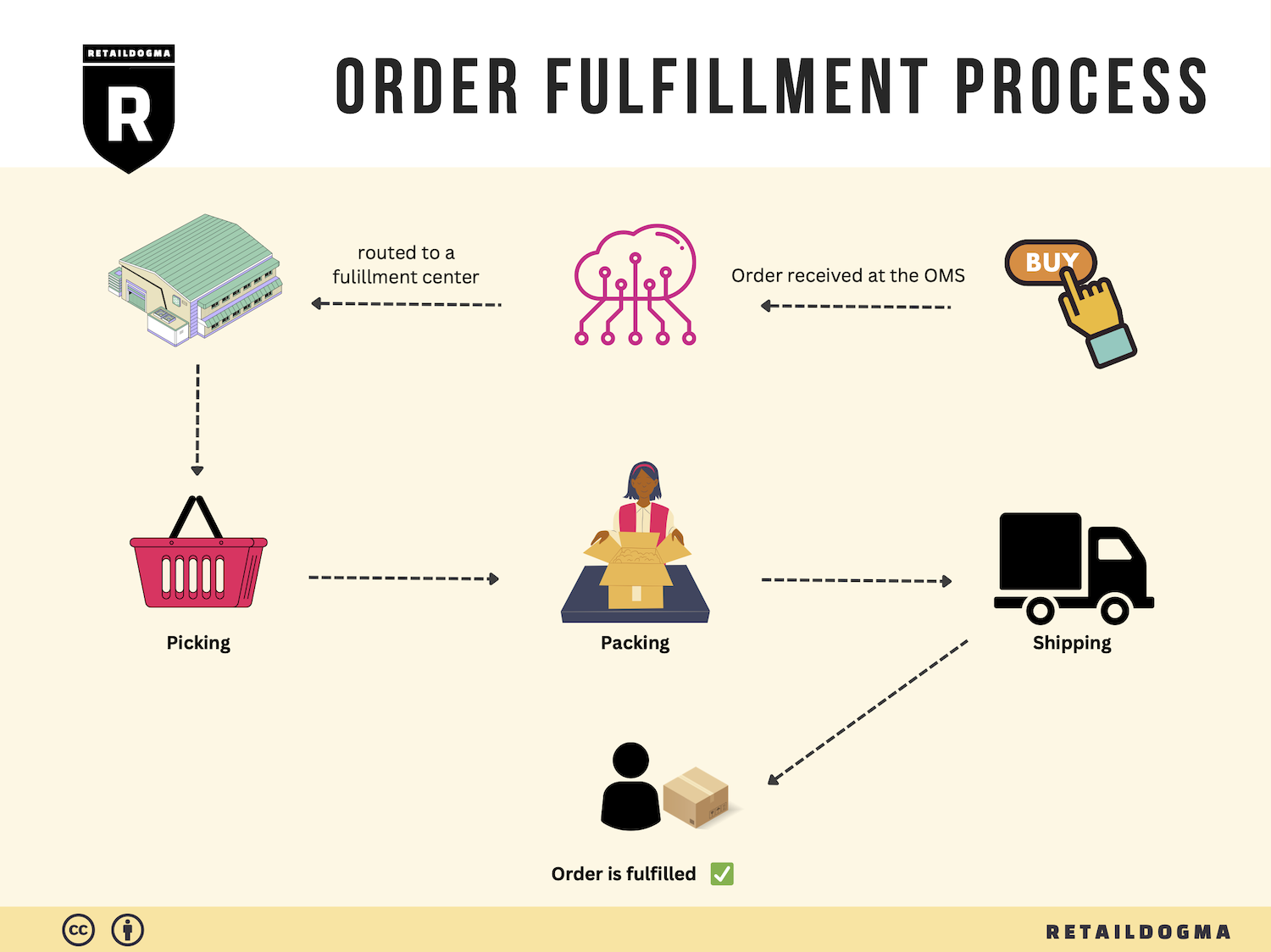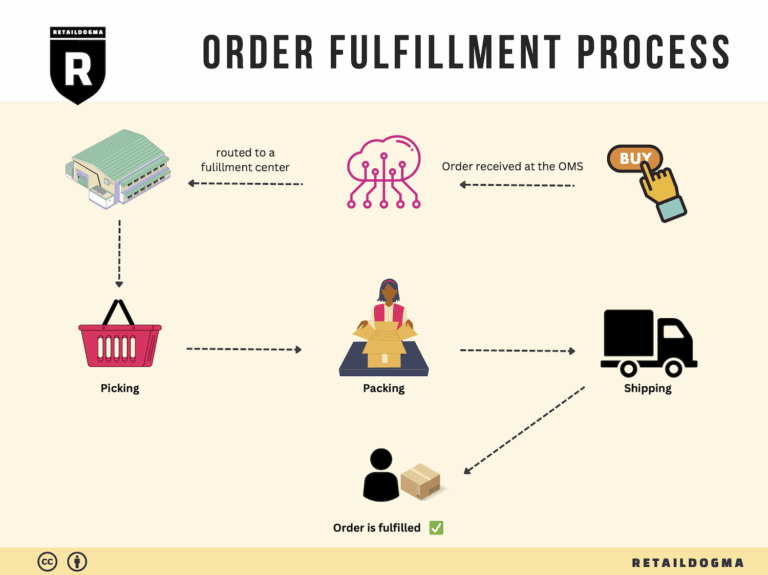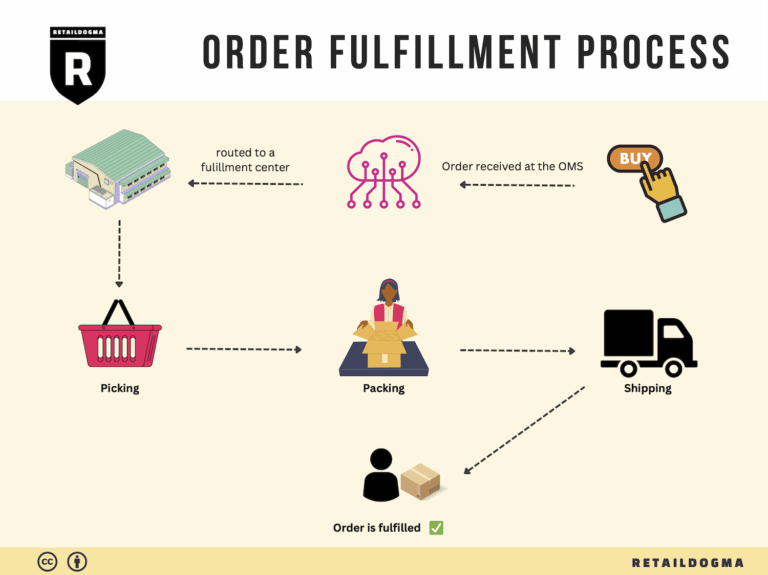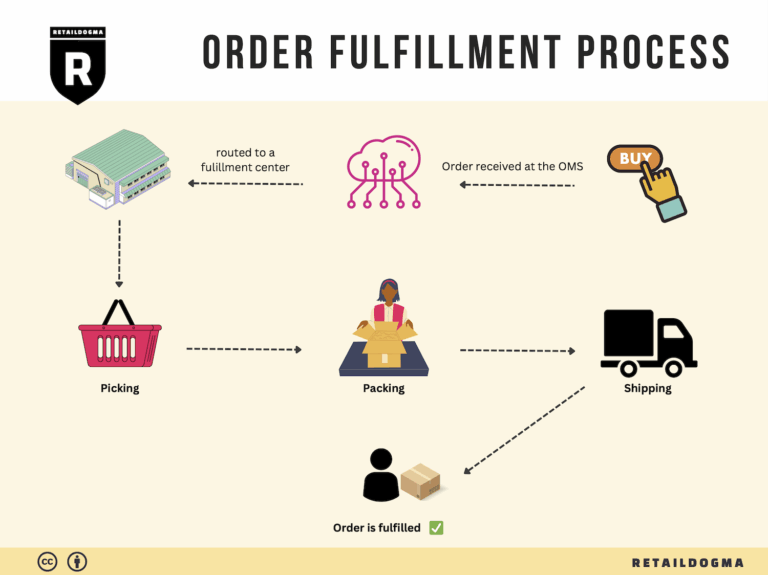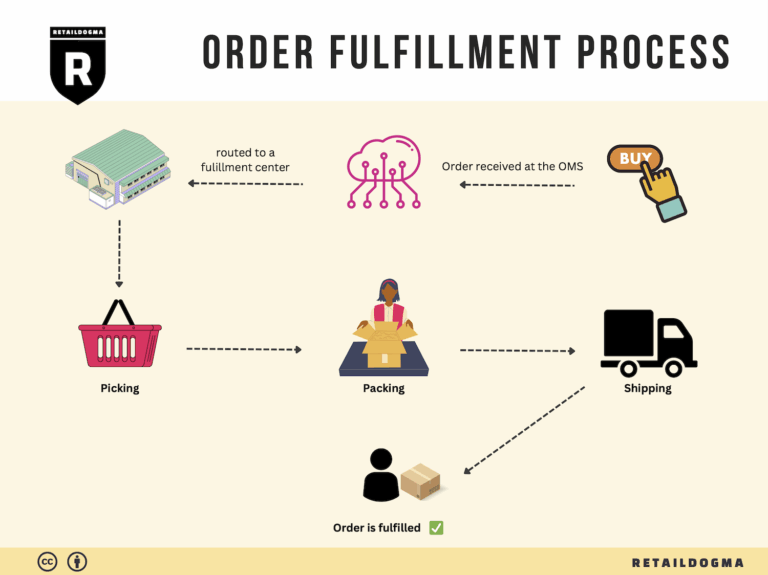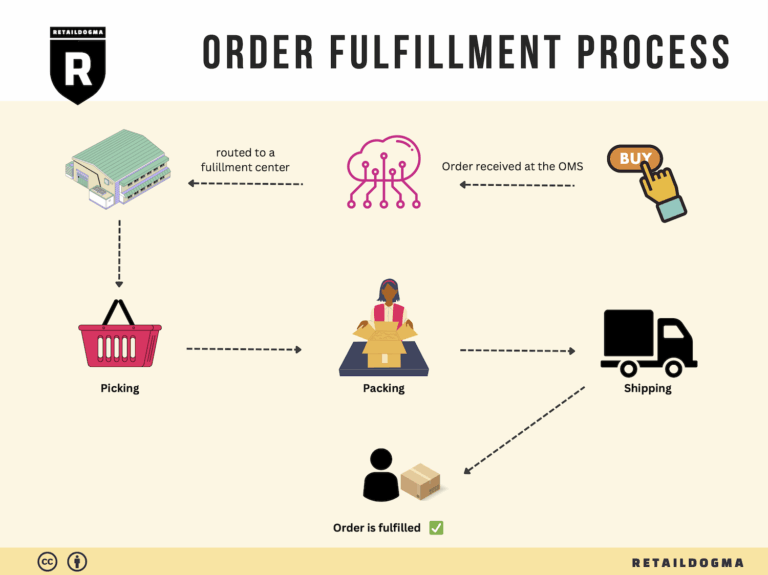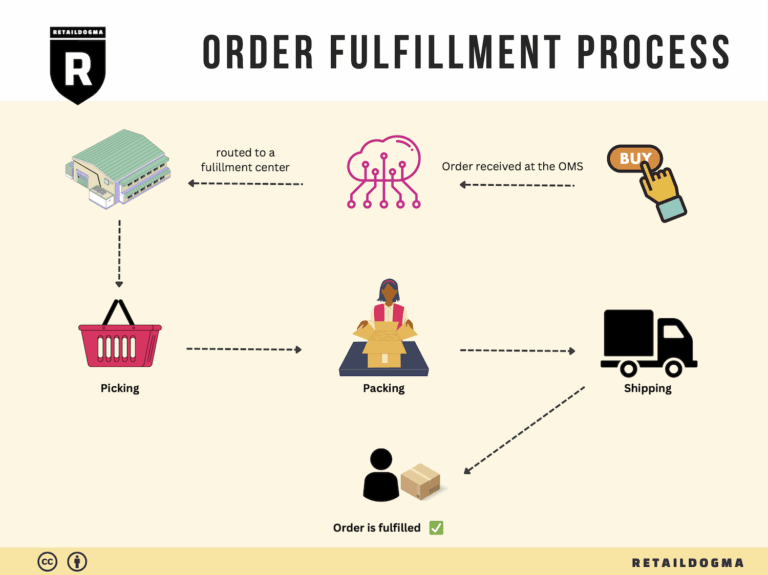What Is A Fulfillment Center? A Complete Guide (2025)
What is E-commerce Fulfillment? An Introduction for Growing Businesses
Understanding E-commerce Fulfillment: A Key to Scaling Your Business
For many growing online businesses, the excitement of increased sales can quickly turn into a daunting challenge when it comes to packing and shipping orders. As orders pile up, the intricacies of logistics can overwhelm even the most organized operations. This is where e-commerce fulfillment comes into play, serving as the backbone of your logistics strategy. In simple terms, fulfillment is the process of getting a product from your inventory to the customer’s doorstep. It encompasses everything from storage and packing to shipping and handling returns.
In this guide, we will explore various fulfillment models, including third-party logistics (3PL) and Fulfillment by Amazon (FBA), to help you understand which might be the best fit for your business. Each model has its own advantages and can significantly impact your operational efficiency and customer satisfaction.
We will also delve into the core services associated with e-commerce fulfillment. These include inventory management, order processing, packaging, shipping, and returns management. Understanding these services will enable you to identify the specific needs of your business and select a fulfillment partner that aligns with those needs.
Choosing the right fulfillment partner is critical for your business’s success. We will provide insights on what to consider when evaluating potential partners, such as their technological capabilities, service offerings, scalability, and customer service.
Moreover, pricing is a crucial aspect of fulfillment that can affect your bottom line. We will outline the various cost structures associated with different fulfillment options, helping you to make informed financial decisions that support your growth.
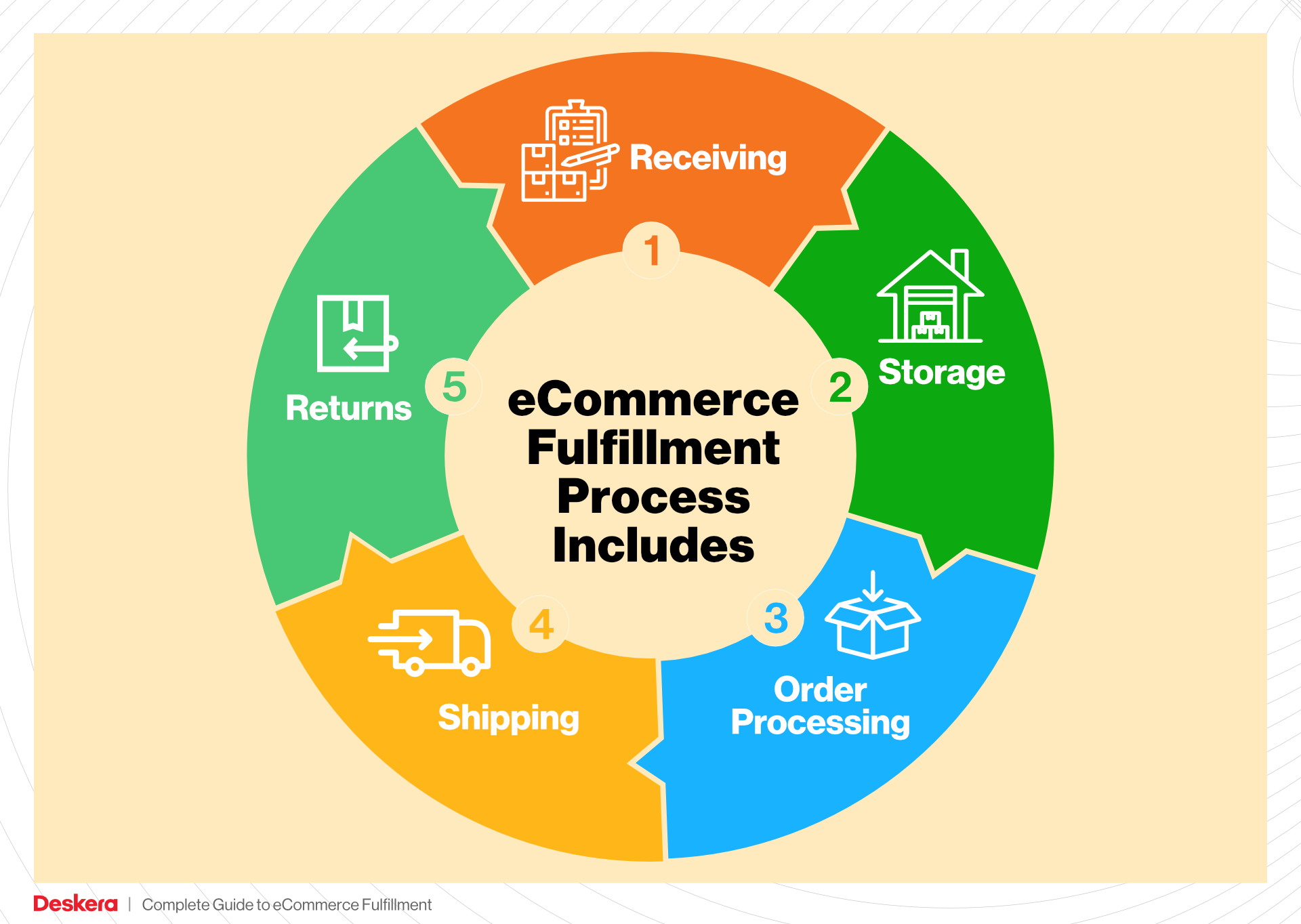
The ultimate goal of this guide is to empower you—business owners, operations managers, and entrepreneurs—with the knowledge to make smart decisions about your logistics strategy. By understanding the complexities of e-commerce fulfillment, you can streamline your operations, enhance customer satisfaction, and position your business for sustainable growth. Whether you’re just starting out or looking to scale your existing operations, mastering fulfillment is key to your e-commerce success.
What You’ll Learn In This Guide
- What is E-commerce Fulfillment? An Introduction for Growing Businesses
- The Order Fulfillment Process: From ‘Buy’ Button to Customer’s Door
- Comparing Fulfillment Models: In-House vs. 3PL vs. Dropshipping
- A Deep Dive into Amazon FBA: Pros, Cons, and Who It’s For
- Core Services Offered by Fulfillment Centers
- How to Choose a Fulfillment Partner: A 6-Point Checklist
- Understanding Fulfillment Pricing: A Breakdown of Common Fees
- Frequently Asked Questions (FAQs) about Fulfillment
- Conclusion: Is Outsourcing Fulfillment the Right Move for Your Business?
- Important Disclaimer
The Order Fulfillment Process: From ‘Buy’ Button to Customer’s Door
1. Receiving Inventory
The order fulfillment process begins with receiving inventory at the fulfillment center. When products arrive from suppliers or manufacturers, they are unloaded and checked for accuracy against the purchase orders. This step is crucial because it ensures that the correct quantities and types of products are received, which prevents future discrepancies that can lead to delays in order processing.
During this phase, items are assigned Stock Keeping Units (SKUs), which serve as unique identifiers for tracking inventory throughout the supply chain. Proper receiving practices not only help maintain accurate inventory levels but also set the stage for efficient warehousing and order fulfillment. By implementing a robust receiving process, businesses can mitigate the risk of stockouts or overstock situations, which can harm customer satisfaction and increase operational costs.
2. Warehouse Storage
Once inventory is received, the next step is warehouse storage. Products are categorized and placed in designated storage locations within the fulfillment center. Effective storage solutions are essential for optimizing space and ensuring easy access to items when orders are placed.
Utilizing a systematic approach, such as ABC analysis, can help prioritize items based on their turnover rates, ensuring that fast-moving products are stored in easily accessible areas. This practice minimizes the time required to locate products when orders come in, thereby improving overall operational efficiency. Additionally, employing technologies such as warehouse management systems (WMS) can enhance tracking and organization, allowing for real-time visibility of inventory levels and locations.
3. Order Picking
When a customer places an order, the fulfillment process shifts to order picking. This involves selecting the right products from the warehouse to fulfill the order. Efficient picking is vital as it directly impacts order accuracy and shipping times, which are critical to customer satisfaction.
A common practice in order picking is the use of pick lists, which provide details on the items to be collected, including their quantities and storage locations. This helps streamline the process and reduce errors. Advanced fulfillment centers, like Amazon’s BFI4, utilize automated systems and robotics to assist with picking. For example, robots may transport inventory directly to pickers, enhancing efficiency and reducing the physical strain on employees. By optimizing the picking process, businesses can ensure faster turnaround times and improved order accuracy.
4. Order Packing
After items are picked, they move to the order packing stage. This step involves securely packaging the products for shipment, ensuring they arrive at the customer’s door in perfect condition. Effective packing is not only about protecting items during transit but also about optimizing shipping costs and enhancing customer experience.
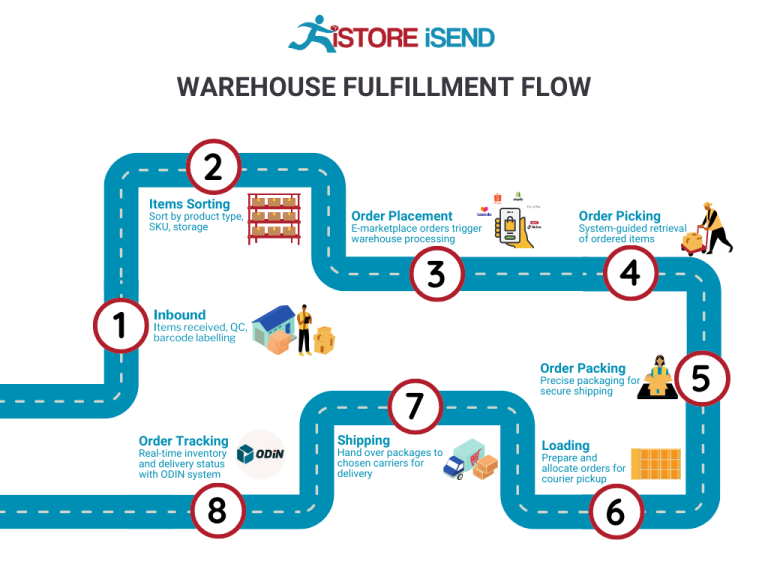
In this phase, businesses often employ packing slips, which include essential order details, and may also utilize automated packing systems that dispense the right amount of packing materials to minimize waste. The use of high-tech solutions, such as tape feeders that dispense the correct length of tape for sealing boxes, can significantly improve efficiency and reduce errors. Properly executed packing processes lead to reduced returns and increased customer satisfaction, as well-packaged items contribute to a positive unboxing experience.
5. Shipping & Delivery
The final step in the order fulfillment process is shipping and delivery. Once orders are packed, they are labeled with shipping information and sorted based on delivery routes. This stage is critical as it determines how quickly customers receive their orders, directly affecting their overall shopping experience.
Businesses often use shipping management systems to optimize carrier selection, ensuring that the most cost-effective and reliable shipping options are utilized. Key performance indicators (KPIs) such as delivery time and shipping accuracy are monitored to assess performance and make necessary adjustments. By focusing on efficient shipping and delivery processes, businesses can enhance their reputation for reliability and speed, which is essential for scaling operations and retaining customers in a competitive e-commerce landscape.
In conclusion, understanding and optimizing each step of the order fulfillment process is essential for e-commerce businesses looking to scale. By focusing on efficient practices from receiving inventory to shipping and delivery, companies can significantly enhance their operational effectiveness and customer satisfaction.
Comparing Fulfillment Models: In-House vs. 3PL vs. Dropshipping
Fulfillment Model Comparison Table
| Model | Who Handles Inventory | Best For (Business Stage) | Key Advantage | Key Disadvantage |
|---|---|---|---|---|
| In-House Fulfillment | The business itself | Established businesses with stable demand | Complete control over inventory and operations | High operational costs and complexity |
| Third-Party Logistics (3PL) | A third-party provider | Growing businesses and startups | Scalability and reduced operational burden | Less control over inventory and shipping |
| Dropshipping | Supplier or manufacturer | Startups and small businesses | Low startup costs and no inventory management | Lower profit margins and potential supplier issues |
In-House Fulfillment
In-house fulfillment involves managing the entire logistics and inventory process within your own facilities. This model is best suited for established businesses with stable demand and sufficient resources to handle logistics. The primary advantage of in-house fulfillment is the complete control it offers over inventory, order processing, and shipping. Businesses can implement customized processes, ensuring that they can quickly adapt to changes in demand or operational challenges. However, this model comes with its drawbacks. The operational costs can be high due to staffing, warehousing, and technology investments. Additionally, managing logistics can become complex, requiring expertise in inventory management, order processing, and shipping logistics, which can distract from core business activities.
Third-Party Logistics (3PL)
Third-party logistics (3PL) refers to outsourcing logistics and fulfillment operations to a specialized provider. This model is ideal for growing businesses and startups that want to focus on core activities like marketing and sales while leaving logistics to experts. The key advantage of using a 3PL provider is scalability; businesses can easily adjust their logistics capacity based on demand fluctuations without incurring the fixed costs associated with in-house operations. 3PL providers typically have established networks and expertise in shipping, which can lead to faster delivery times and potentially lower shipping costs. However, the downside is that businesses may have less control over their inventory and shipping processes, which could lead to inconsistencies in customer service if the 3PL provider does not meet expectations.
Dropshipping
Dropshipping is a fulfillment model where the retailer does not keep the products it sells in stock. Instead, when a retailer sells a product, it purchases the item from a third-party supplier, who then ships it directly to the customer. This model is particularly suitable for startups and small businesses, as it involves low startup costs and eliminates the need for inventory management. Retailers can offer a wide range of products without the financial burden of purchasing and storing inventory upfront. However, dropshipping has its challenges. Profit margins tend to be lower compared to other fulfillment models since the retailer is paying a premium for the convenience of not handling inventory. Additionally, retailers are dependent on suppliers for product quality and shipping times, which can lead to customer dissatisfaction if not managed carefully. This reliance on third parties can create issues in maintaining brand integrity and customer experience.
Conclusion
Choosing the right fulfillment model is critical for e-commerce businesses, as it directly impacts operational efficiency, customer satisfaction, and overall profitability. Each model has its unique advantages and disadvantages that must be carefully considered in relation to the specific needs and stage of the business. By understanding the nuances of in-house fulfillment, third-party logistics, and dropshipping, business owners can make informed decisions that align with their strategic goals and growth plans.
A Deep Dive into Amazon FBA: Pros, Cons, and Who It’s For
Understanding Fulfillment by Amazon (FBA)
Fulfillment by Amazon (FBA) is a service provided by Amazon that allows e-commerce sellers to store their products in Amazon’s fulfillment centers. Once a customer places an order, Amazon takes care of storage, packaging, shipping, and customer service on behalf of the seller. This streamlined process allows sellers to focus on other aspects of their business while leveraging Amazon’s robust logistics and customer service capabilities.
How FBA Works
-
Product Storage: Sellers send their products to Amazon’s fulfillment centers, where they are stored until sold. Amazon has over 900 fulfillment centers globally, including the BFI4 center in Kent, Washington, which processes over a million packages daily.
-
Order Processing: When a customer places an order, Amazon’s sophisticated algorithms and automated systems pick the product from the shelves. Robots transport items to packing stations, where human workers package them for shipment.
-
Shipping: Amazon handles the shipping of the products directly to the customer. With their extensive logistics network, they can often provide same-day or next-day delivery, which is a major selling point for customers.
-
Customer Service and Returns: Amazon also manages customer inquiries and returns for FBA products, alleviating sellers from these often time-consuming tasks. This includes processing refunds and handling customer complaints.
Pros of Using FBA
-
Prime Eligibility: One of the most significant advantages of FBA is that it makes your products eligible for Amazon Prime. Prime members are more likely to purchase items that offer fast shipping, which can significantly boost your sales.
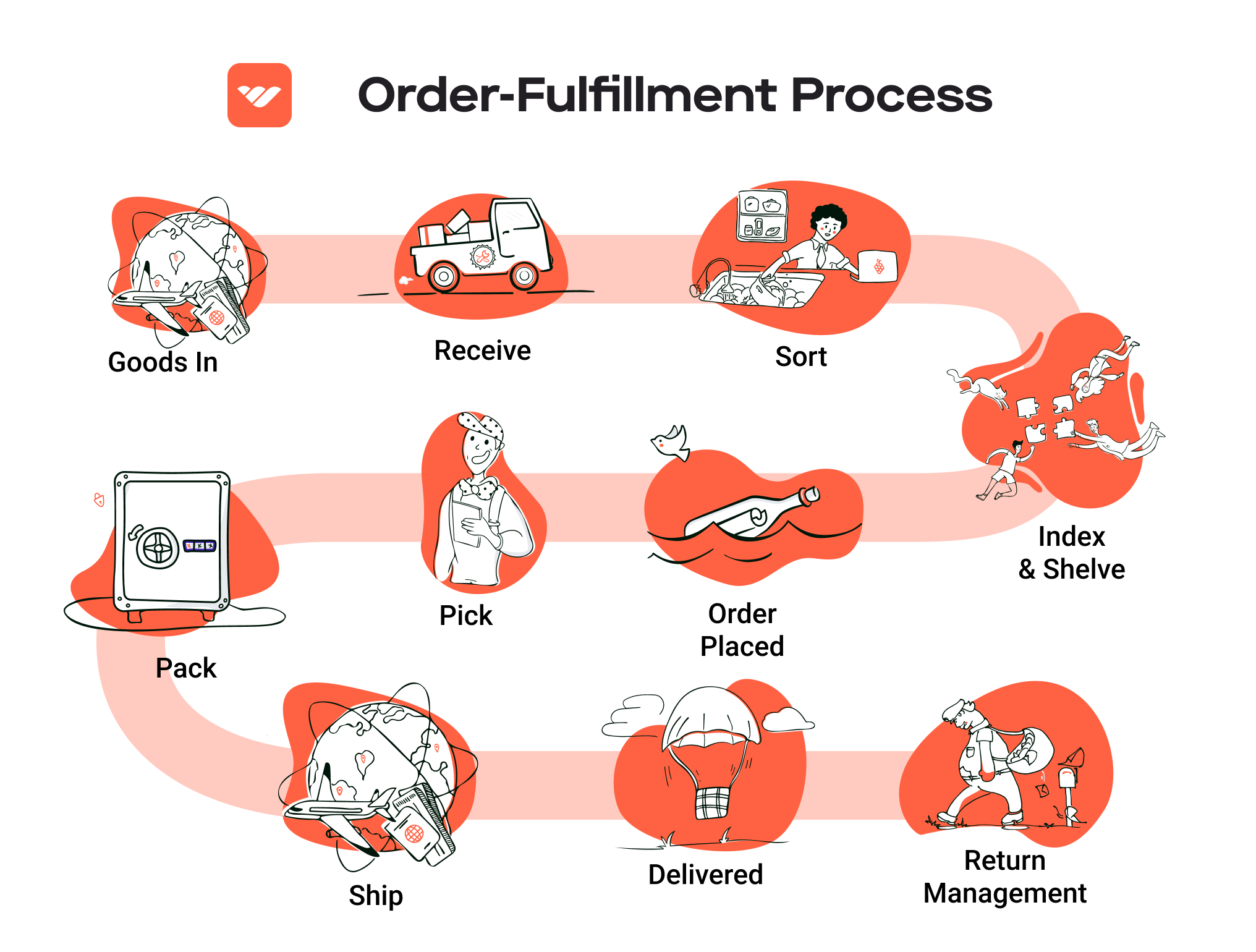
-
Customer Trust: Products fulfilled by Amazon tend to instill more confidence in buyers. The Amazon brand is synonymous with reliability and customer service, which can lead to higher conversion rates for FBA sellers.
-
Multi-Channel Fulfillment: FBA allows sellers to use Amazon’s fulfillment services for sales made outside of Amazon’s platform. This means you can sell on your website or other marketplaces while still utilizing Amazon’s logistics capabilities.
-
Scalability: FBA enables sellers to scale their businesses without worrying about the logistics of order fulfillment. As your sales grow, Amazon can handle the increased volume, allowing you to focus on marketing and product development.
-
Inventory Management: Amazon’s technology provides detailed inventory reports and analytics, helping sellers manage their stock levels more effectively and avoid stockouts or overstock situations.
Cons of Using FBA
-
High Fees: FBA comes with various fees, including storage fees and fulfillment fees, which can cut into your profit margins. Sellers need to ensure that their pricing strategy accounts for these costs to maintain profitability.
-
Strict Inventory Rules: Amazon has stringent policies regarding inventory management, including limitations on certain types of products and strict compliance requirements. Sellers must be diligent in adhering to these rules to avoid penalties or account suspensions.
-
Commingling Risks: When using FBA, products from different sellers may be stored together. This commingling can lead to risks, such as receiving returns of a different seller’s products or facing issues with counterfeit items. Sellers must be aware of these risks and take precautions, such as using unique barcodes.
-
Loss of Control: By outsourcing fulfillment to Amazon, sellers relinquish some control over the shipping process and customer experience. This can be a concern for brands that prioritize a specific customer service approach or packaging style.
-
Inventory Limits: Amazon imposes limits on the amount of inventory you can send to their warehouses, particularly for new sellers or those with a history of slow-moving inventory. This can be a barrier for scaling your operations effectively.
Who is FBA Best For?
Fulfillment by Amazon is particularly well-suited for:
-
Small to Medium-Sized Businesses: FBA can be an excellent option for small to medium-sized e-commerce businesses that lack the infrastructure to manage logistics effectively. It allows these sellers to compete with larger brands without needing extensive operational resources.
-
Sellers with High Volume: Businesses that have a high volume of sales can benefit significantly from FBA, as the efficiencies gained from Amazon’s logistics network can lead to improved order fulfillment times and customer satisfaction.
-
Brands Looking for Growth: If you are a brand looking to scale quickly, FBA can provide the infrastructure needed to handle increased sales while maintaining a focus on marketing and product development.
-
Multi-Channel Sellers: Businesses that sell on multiple platforms will find FBA beneficial as it can streamline their fulfillment process across different sales channels.
-
Sellers of High-Demand Products: If your products are consistently in demand, the benefits of FBA, including Prime eligibility and rapid shipping, can help you capture a larger market share.
In conclusion, Fulfillment by Amazon offers a powerful set of tools for e-commerce sellers looking to enhance their operational efficiency and customer reach. However, it is essential to weigh the pros and cons carefully and consider your specific business needs before committing to the FBA program. By understanding how FBA works and its implications, you can make an informed decision that aligns with your growth strategy.
Core Services Offered by Fulfillment Centers
Inventory Management & Warehousing
Fulfillment centers play a critical role in the management and storage of inventory for e-commerce businesses. They provide a centralized location where products can be stored, organized, and easily accessed. Advanced inventory management systems are often integrated within these centers, enabling businesses to maintain real-time visibility of their stock levels. This technology helps businesses avoid overstocking or stockouts, which can lead to lost sales and dissatisfied customers.
The benefits of efficient inventory management and warehousing are manifold. First, it allows for streamlined operations, reducing the time spent on manual tracking of inventory. Second, it enhances order fulfillment speed, as products are organized logically and can be quickly retrieved when orders come in. Third, it can lead to cost savings by optimizing storage space and reducing overhead costs associated with maintaining a separate warehouse. For businesses looking to scale, efficient inventory management is essential for ensuring that they can meet customer demand without incurring unnecessary costs.
Pick and Pack Services
Pick and pack services are the heartbeat of fulfillment operations. This process involves selecting products from the warehouse (picking) and then packing them for shipment to customers. In a fulfillment center, this is typically facilitated by a combination of human labor and automation, such as conveyor belts and robotic systems, which enhance speed and accuracy.
The primary benefit of pick and pack services is the ability to fulfill orders quickly and accurately. For e-commerce businesses, customer satisfaction hinges on timely deliveries. By utilizing a fulfillment center’s pick and pack capabilities, businesses can reduce their order processing times significantly. Additionally, these services often include quality control checks, ensuring that the right products are shipped in the correct quantities. This not only minimizes returns but also fosters customer trust and loyalty, which are vital for long-term growth.
Kitting and Assembly
Kitting and assembly services involve the grouping of various products together to create a single, bundled product that is sold as one unit. This could range from assembling a gift basket to creating a complex product that requires multiple components. Fulfillment centers are equipped to handle these specialized services, allowing businesses to offer unique product combinations that enhance their market appeal.
The benefits of kitting and assembly are particularly important for businesses looking to differentiate themselves in a competitive market. By offering bundled products, companies can increase their average order value and improve customer satisfaction by providing convenience. Moreover, outsourcing this process to a fulfillment center allows businesses to focus on their core competencies, such as marketing and product development, rather than getting bogged down in the logistics of assembly. This strategic approach to product offerings can lead to increased sales and improved customer retention.
Returns Management (Reverse Logistics)
Returns management, also known as reverse logistics, is an essential service offered by fulfillment centers. This process involves handling returned products, assessing their condition, restocking them if possible, or managing the disposal of unsellable items. Efficient returns management is crucial for maintaining customer satisfaction, as a seamless return process can significantly influence a customer’s future purchasing decisions.
The primary benefit of effective returns management is the enhancement of customer experience. A straightforward, hassle-free return process encourages customers to shop with confidence, knowing that they can easily return items if needed. Additionally, fulfillment centers can analyze return data to identify patterns and reasons for returns, which can provide valuable insights for businesses. This information can be used to improve product quality, adjust marketing strategies, or refine inventory selections, ultimately leading to reduced return rates and increased profitability.
In conclusion, leveraging the core services offered by fulfillment centers can provide e-commerce businesses with the infrastructure and expertise necessary to scale operations efficiently. By focusing on inventory management, pick and pack services, kitting and assembly, and returns management, businesses can enhance their operational efficiency, improve customer satisfaction, and drive long-term growth.
How to Choose a Fulfillment Partner: A 6-Point Checklist
Location & Warehouse Network
Importance:
The geographical location of your fulfillment partner’s warehouses is critical for efficient shipping and delivery times. A partner with strategically placed warehouses can help you reduce shipping costs and ensure faster delivery to your customers.
Questions to Ask:
– Where are your warehouses located in relation to our primary customer base?
– How many fulfillment centers do you operate, and what is their capacity?
– Do you have a plan for expanding your warehouse network in the future?
Technology & Integrations
Importance:
In today’s e-commerce landscape, technology plays a pivotal role in streamlining operations. A fulfillment partner with advanced technology can provide real-time inventory tracking, automated order processing, and seamless integration with your e-commerce platform.
Questions to Ask:
– What technology do you use for order management and inventory tracking?
– Can your system integrate with our existing e-commerce platforms (like Shopify, Amazon, etc.)?
– How do you handle updates or upgrades to your technology? Is there a dedicated team for this?
Specializations (e.g., Cold Storage, Oversized Items)
Importance:
If your products require specific handling or storage conditions—such as temperature control for perishables or special care for oversized items—it’s vital to choose a partner with the right capabilities. This ensures compliance with regulations and maintains product integrity.
Questions to Ask:
– Do you have specialized facilities for handling specific types of products, such as cold storage or oversized items?
– What certifications do you hold for handling sensitive products?
– Can you provide case studies or examples of how you’ve successfully managed specialized fulfillment needs?
Scalability & Capacity
Importance:
As your business grows, your fulfillment needs will likely change. It’s essential to partner with a fulfillment provider that can scale operations up or down based on demand fluctuations, especially during peak seasons.
Questions to Ask:
– How do you manage seasonal spikes in order volume?
– What is your current capacity, and how quickly can you scale up operations if needed?
– Do you have a contingency plan in place for unforeseen demand surges?
Pricing and Contracts
Importance:
Understanding the pricing structure and contract terms is crucial to avoid unexpected costs that can impact your bottom line. A transparent pricing model helps you budget effectively and ensures that you are getting value for your money.
Questions to Ask:
– What is included in your pricing structure (e.g., storage fees, picking and packing fees, shipping costs)?
– Are there any additional fees we should be aware of (e.g., for returns, special handling)?
– What are the contract terms, and is there flexibility for renegotiation as our needs change?
Customer Support & Reviews
Importance:
Reliable customer support is essential for resolving issues quickly and maintaining smooth operations. Additionally, researching reviews and testimonials can provide insights into the partner’s reliability and service quality.
Questions to Ask:
– What support channels do you offer (e.g., phone, email, chat), and what are your typical response times?
– Can you provide references from other clients, especially those in our industry?
– How do you handle customer complaints or issues? What is your escalation process?
Conclusion
Choosing the right fulfillment partner is a strategic decision that can significantly impact your e-commerce business’s success. By using this checklist, you can systematically evaluate potential partners based on key operational criteria. Prioritize your business needs and align them with a partner that not only meets those requirements but also offers the potential for future growth and adaptability in an ever-evolving market. Always remember that the right partnership can enhance your customer experience, streamline operations, and ultimately drive sales.
Understanding Fulfillment Pricing: A Breakdown of Common Fees
Initial Setup Fees
Initial setup fees are typically charged when you begin using a fulfillment service. These fees cover the administrative costs of onboarding your account and integrating your inventory into the fulfillment center’s systems. In the context of Amazon Fulfillment Centers like BFI4, this can involve the creation of your seller account, the setup of product listings, and potentially the configuration of your shipping preferences.
The calculation of initial setup fees can vary widely based on the complexity of your business needs. Some fulfillment centers may charge a flat fee, while others might base their charges on the number of SKUs (Stock Keeping Units) you have or the amount of inventory being transferred. It’s essential to clarify what specific services are included in these fees to avoid unexpected costs.
Receiving Fees
Receiving fees are charged for the process of accepting and checking in your inventory at the fulfillment center. This includes unloading your goods, inspecting them for damage, and entering them into the inventory management system.
Typically, receiving fees are calculated per pallet or per unit, depending on the fulfillment center’s pricing structure. For example, Amazon might charge a standard rate for each pallet received, while others might charge based on the total number of items. Understanding how these fees are structured is critical, especially if you plan to send large shipments, as costs can add up quickly.
Storage Fees (per pallet/bin)
Storage fees are incurred for holding your inventory in the fulfillment center. These fees are typically calculated on a per-pallet or per-bin basis and can vary by season. For example, during peak seasons like the holidays, storage fees may increase due to higher demand for space.
Storage fees are usually charged monthly and can be influenced by the volume of inventory you maintain. Amazon’s BFI4, like many fulfillment centers, may offer tiered pricing; the more you store, the lower the per-pallet cost might be. Additionally, some fulfillment centers may impose long-term storage fees if items remain unsold for an extended period, incentivizing sellers to manage their inventory effectively.
Pick & Pack Fees (per item/order)
Pick and pack fees refer to the costs associated with retrieving items from storage and packing them for shipment. This process is crucial for ensuring that customer orders are fulfilled accurately and efficiently.
These fees are generally calculated per item or per order. For instance, if an order includes multiple items, you may be charged a fee for each item picked and packed. Some fulfillment centers offer a flat fee per order regardless of the number of items, which can be beneficial for businesses with high-order volumes and low-item counts. Understanding the specifics of pick and pack fees will help you estimate fulfillment costs accurately and optimize your order sizes accordingly.
Shipping Fees
Shipping fees are incurred when your products are dispatched to customers. These fees can vary based on several factors, including the destination, shipping method (standard, expedited, etc.), and the weight or dimensions of the package.
For Amazon Fulfillment Centers, shipping fees are often based on a combination of weight and distance. This means that heavier and longer-distance shipments will incur higher fees. Additionally, fulfillment centers may offer negotiated shipping rates with carriers, which can affect the overall cost. It’s essential to factor in these shipping fees when calculating your total fulfillment expenses, as they can significantly impact your profit margins.
Tips for Getting an Accurate Quote
-
Understand Your Needs: Clearly define your inventory management and fulfillment requirements. Knowing your average order size, inventory turnover rate, and peak sales periods will help you get a more accurate estimate.
-
Request a Detailed Breakdown: When seeking quotes from fulfillment centers, ask for a detailed breakdown of all potential fees. This should include initial setup, receiving, storage, pick and pack, and shipping fees.
-
Negotiate Terms: Don’t hesitate to negotiate terms, especially if you expect to have a high volume of orders. Many fulfillment centers are open to discussing rates for long-term partnerships.
-
Consider Seasonal Variations: Be aware of potential seasonal price changes, particularly for storage and shipping fees. Factor these into your budgeting to avoid surprises during peak seasons.
-
Utilize Technology: Leverage fulfillment management software to track your inventory and orders. This can help you optimize your operations and provide more accurate forecasts for your fulfillment needs.
By understanding these common fulfillment pricing models and following these tips, e-commerce business owners can better manage their logistics costs and ultimately enhance their profitability.
Frequently Asked Questions (FAQs) about Fulfillment
1. What is Amazon Fulfillment Center BFI4?
Amazon Fulfillment Center BFI4 is a state-of-the-art logistics facility located in Kent, Washington. It is designed to efficiently process and ship over a million packages daily, utilizing advanced robotics and algorithms to optimize operations. This facility is pivotal in Amazon’s supply chain, ensuring quick and accurate delivery of products to customers.
2. How does BFI4 differ from a traditional warehouse?
A traditional warehouse primarily serves as a storage space for goods, focusing on inventory management. In contrast, a fulfillment center like BFI4 is equipped with advanced technology and processes to pick, pack, and ship orders directly to customers. Fulfillment centers streamline the order fulfillment process, reducing lead times and enhancing customer satisfaction.
3. What technologies are used at BFI4?
BFI4 employs a variety of cutting-edge technologies, including automated robots for transporting products, advanced conveyor systems for sorting and moving items, and sophisticated algorithms for inventory management. These technologies work together to enhance efficiency, accuracy, and speed in order processing.
4. What is the role of humans in the fulfillment process at BFI4?
While automation plays a significant role at BFI4, human associates are essential for tasks that require decision-making, quality control, and customer service. Workers interact with technology, such as using light-guided systems to pick items from robotic pods, ensuring a seamless integration of human and machine labor.
5. How much do fulfillment services cost at Amazon?
The cost of fulfillment services at Amazon varies based on factors like product size, weight, and the specific services required (e.g., storage, packing, shipping). Generally, fees may include storage fees for inventory held in the fulfillment center and fulfillment fees for each item shipped. It is recommended to use Amazon’s pricing calculator to get a tailored estimate based on your business needs.
6. What is a Third-Party Logistics Provider (3PL)?
A Third-Party Logistics Provider (3PL) is a service provider that manages logistics and supply chain functions for businesses. This can include warehousing, inventory management, transportation, and order fulfillment. Using a 3PL can help businesses scale operations without the need to invest in their own logistics infrastructure.
7. Can businesses tour the BFI4 fulfillment center?
Yes, Amazon offers public tours of the BFI4 fulfillment center, allowing visitors to see the inner workings of the facility. These tours showcase the technology and processes involved in fulfilling orders, providing insights into how Amazon manages logistics at scale.
8. What types of products can be fulfilled at BFI4?
BFI4 is capable of handling a wide variety of products, from small items like electronics and books to larger goods such as furniture. However, certain restrictions may apply based on size, weight, and safety regulations. It is essential to check Amazon’s guidelines for specific product categories.
9. How does Amazon ensure the safety of employees at BFI4?
Amazon prioritizes employee safety through comprehensive training programs, strict adherence to safety protocols, and the implementation of ergonomic practices. The facility is designed with safety measures in mind, including automated systems that minimize manual handling and reduce the risk of injury.
10. What is the future of fulfillment centers like BFI4?
The future of fulfillment centers like BFI4 lies in continued advancements in automation, artificial intelligence, and data analytics. These technologies will enhance efficiency, improve inventory management, and allow for even faster delivery times. As e-commerce continues to grow, fulfillment centers will play a crucial role in meeting consumer demands for speed and reliability.
Conclusion: Is Outsourcing Fulfillment the Right Move for Your Business?
Evaluating the Benefits of Outsourcing Fulfillment
As an e-commerce business owner, the decision to outsource fulfillment is a pivotal one that can significantly impact your operations and growth trajectory. Utilizing a fulfillment service offers several key advantages that can streamline your processes and enhance your customer satisfaction.
Firstly, outsourcing fulfillment saves valuable time. By leveraging a specialized partner, you can redirect focus from logistics to core business activities such as marketing and product development. This shift allows you to innovate and improve your offerings while ensuring that your customers receive their orders promptly.
Secondly, scalability becomes a seamless process when you engage with a fulfillment provider. As your sales volume fluctuates—whether during peak seasons or in response to successful marketing campaigns—outsourcing allows you to adjust your logistics capabilities without the overhead of maintaining a large in-house operation. This flexibility can be crucial in navigating the unpredictable landscape of e-commerce.
Furthermore, partnering with an experienced fulfillment service grants you access to industry expertise and advanced technologies that may be otherwise unattainable for small to mid-sized businesses. For example, companies like Amazon leverage sophisticated algorithms and automation to optimize order processing, which translates into faster shipping times and reduced errors.
However, the key to realizing these benefits lies in choosing the right fulfillment partner. Consider factors such as their technology stack, reliability, geographical reach, and customer service capabilities. A well-aligned partner can become an extension of your business, contributing to your growth and customer loyalty.
Call to Action
To determine if outsourcing fulfillment is the right step for your business, conduct an audit of your current shipping process. Assess your operational challenges, capacity for growth, and customer expectations. This analysis will help you identify whether a fulfillment partner could enhance your logistics strategy and support your long-term goals. Take the leap—streamline your operations and focus on what you do best.
Important Disclaimer
⚠️ Important Disclaimer
The information in this guide is for educational purposes. Fulfillment services, pricing, and platform features change frequently. Always conduct your own due diligence and consult with providers directly before making business decisions.
